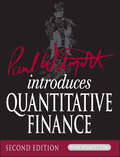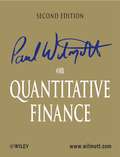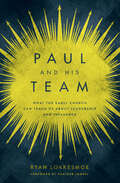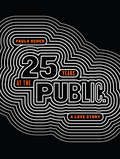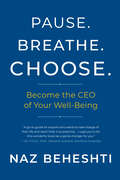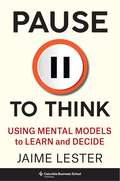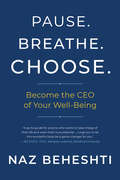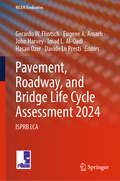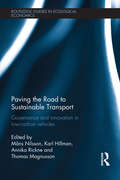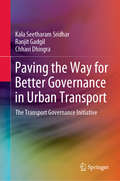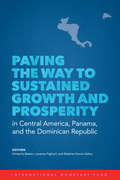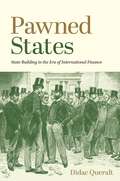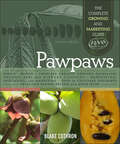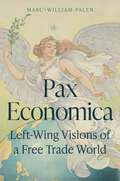- Table View
- List View
Paul Volcker: The Making of a Financial Legend
by Joseph B. TreasterAs the Chairman of the Federal Reserve from 1979 to 1982, Paul Volcker established himself as one of the most influential economic thinkers. Currently a major advocate for corporate governance and accounting reforms, Volcker’s reputation as a great business leader with uncompromising ethics continues to this day. Written by award-winning New York Times journalist Joseph Treaster, Paul Volcker: The Making of a Financial Legend takes readers through the most compelling moments of this legend’s life in private and public service. From his early days as a young Treasury Department official through his appointments to the New York Federal Reserve Bank, the Federal Reserve, and James D. Wolfensohn, Inc., this inspiring book captures the significant moments in Volcker life and explores the ethical, economic, and moral dilemmas he faced at every turn.
Paul Wilmott Introduces Quantitative Finance
by Paul WilmottPaul Wilmott Introduces Quantitative Finance, Second Edition is an accessible introduction to the classical side of quantitative finance specifically for university students. Adapted from the comprehensive, even epic, works Derivatives and Paul Wilmott on Quantitative Finance, Second Edition, it includes carefully selected chapters to give the student a thorough understanding of futures, options and numerical methods. Software is included to help visualize the most important ideas and to show how techniques are implemented in practice. There are comprehensive end-of-chapter exercises to test students on their understanding.
Paul Wilmott Introduces Quantitative Finance (The Wiley Finance Series)
by Paul WilmottPaul Wilmott Introduces Quantitative Finance, Second Edition is an accessible introduction to the classical side of quantitative finance specifically for university students. Adapted from the comprehensive, even epic, works Derivatives and Paul Wilmott on Quantitative Finance, Second Edition, it includes carefully selected chapters to give the student a thorough understanding of futures, options and numerical methods. Software is included to help visualize the most important ideas and to show how techniques are implemented in practice. There are comprehensive end-of-chapter exercises to test students on their understanding.
Paul Wilmott on Quantitative Finance
by Paul WilmottPaul Wilmott on Quantitative Finance, Second Edition provides a thoroughly updated look at derivatives and financial engineering, published in three volumes with additional CD-ROM.Volume 1: Mathematical and Financial Foundations; Basic Theory of Derivatives; Risk and Return.The reader is introduced to the fundamental mathematical tools and financial concepts needed to understand quantitative finance, portfolio management and derivatives. Parallels are drawn between the respectable world of investing and the not-so-respectable world of gambling.Volume 2: Exotic Contracts and Path Dependency; Fixed Income Modeling and Derivatives; Credit RiskIn this volume the reader sees further applications of stochastic mathematics to new financial problems and different markets.Volume 3: Advanced Topics; Numerical Methods and Programs.In this volume the reader enters territory rarely seen in textbooks, the cutting-edge research. Numerical methods are also introduced so that the models can now all be accurately and quickly solved.Throughout the volumes, the author has included numerous Bloomberg screen dumps to illustrate in real terms the points he raises, together with essential Visual Basic code, spreadsheet explanations of the models, the reproduction of term sheets and option classification tables. In addition to the practical orientation of the book the author himself also appears throughout the book--in cartoon form, readers will be relieved to hear--to personally highlight and explain the key sections and issues discussed.Note: CD-ROM/DVD and other supplementary materials are not included as part of eBook file.
Paul Wilmott on Quantitative Finance
by Paul WilmottPaul Wilmott on Quantitative Finance, Second Edition provides a thoroughly updated look at derivatives and financial engineering, published in three volumes with additional CD-ROM. Volume 1: Mathematical and Financial Foundations; Basic Theory of Derivatives; Risk and Return. The reader is introduced to the fundamental mathematical tools and financial concepts needed to understand quantitative finance, portfolio management and derivatives. Parallels are drawn between the respectable world of investing and the not-so-respectable world of gambling. Volume 2: Exotic Contracts and Path Dependency; Fixed Income Modeling and Derivatives; Credit Risk In this volume the reader sees further applications of stochastic mathematics to new financial problems and different markets. Volume 3: Advanced Topics; Numerical Methods and Programs. In this volume the reader enters territory rarely seen in textbooks, the cutting-edge research. Numerical methods are also introduced so that the models can now all be accurately and quickly solved. Throughout the volumes, the author has included numerous Bloomberg screen dumps to illustrate in real terms the points he raises, together with essential Visual Basic code, spreadsheet explanations of the models, the reproduction of term sheets and option classification tables. In addition to the practical orientation of the book the author himself also appears throughout the book—in cartoon form, readers will be relieved to hear—to personally highlight and explain the key sections and issues discussed. Note: CD-ROM/DVD and other supplementary materials are not included as part of eBook file.
Paul and His Team: What the Early Church Can Teach Us About Leadership and Influence
by Ryan LokkesmoeWhat can we learn about leadership and influence from Paul? Most Christians know something of the apostle Paul&’s life and ministry, but what about the incredible team of influencers he assembled and mobilized? Who were they, and how did Paul lead this team to accomplish God&’s purposes? Even more, what can we learn from their successes and failures, and how can we imitate their qualities? These are the questions that inspired Ryan Lokkesmoe, PhD, to write Paul and His Team. Like a church-ministry version of Team of Rivals, it reveals important principles about leadership and influence by showing how this early ministry team:Adapted to cultural, doctrinal, and interpersonal challengesFound common ground with their audiencesLed baby believers toward maturity Stayed united despite differing opinions Equipped others for the work of the ministryConducted their lives with self-discipline Built and maintained strategic partnerships Navigated sensitive cross-cultural situationsPersisted through difficulty, frustration, and fractured relationships Persevered when ministry was discouragingDeveloped leaders to replace themWhether you are in a position of leadership or are simply a passionate follower of Christ, you are an influencer that God is using to build His church. And while Paul and His Team certainly reveals a lot about Paul's character as a leader, it also highlights both prominent and obscure members of his team to offer a textured portrait of the early church&’s influence in spreading the gospel. Let&’s learn from the men and women God used to build the church, letting them shape our leadership and influence as we continue their work. Includes group discussion questions at the end of each chapter, making this book ideal for a church-staff or small group study.
Paul and His Team: What the Early Church Can Teach Us About Leadership and Influence
by Ryan LokkesmoeWhat can we learn about leadership and influence from Paul? Most Christians know something of the apostle Paul&’s life and ministry, but what about the incredible team of influencers he assembled and mobilized? Who were they, and how did Paul lead this team to accomplish God&’s purposes? Even more, what can we learn from their successes and failures, and how can we imitate their qualities? These are the questions that inspired Ryan Lokkesmoe, PhD, to write Paul and His Team. Like a church-ministry version of Team of Rivals, it reveals important principles about leadership and influence by showing how this early ministry team:Adapted to cultural, doctrinal, and interpersonal challengesFound common ground with their audiencesLed baby believers toward maturity Stayed united despite differing opinions Equipped others for the work of the ministryConducted their lives with self-discipline Built and maintained strategic partnerships Navigated sensitive cross-cultural situationsPersisted through difficulty, frustration, and fractured relationships Persevered when ministry was discouragingDeveloped leaders to replace themWhether you are in a position of leadership or are simply a passionate follower of Christ, you are an influencer that God is using to build His church. And while Paul and His Team certainly reveals a lot about Paul's character as a leader, it also highlights both prominent and obscure members of his team to offer a textured portrait of the early church&’s influence in spreading the gospel. Let&’s learn from the men and women God used to build the church, letting them shape our leadership and influence as we continue their work. Includes group discussion questions at the end of each chapter, making this book ideal for a church-staff or small group study.
Paula Evans and the Redesign of the Cambridge Rindge and Latin School (A)
by Linda A. Hill Kristin C. Doughty Ellen PruynePaula Evans is in her second year as principal of the only high school in Cambridge, MA. Her mandate when she arrived was to redesign the high school so that long-standing inequities in academic achievement rates across race and socioeconomic class were removed. In her first year, she succeeded in obtaining approval for her proposed redesign and completing the physical and administrative restructuring of the high school. Now in her second year, the reforms in how teachers teach and how the school operates are fully under way. From early indications, she and her hand-picked leadership team are moving the school in the desired direction. But the school committee has just made a policy decision that Evans and her team believe will undo all of the redesign efforts that have been made thus far. Evans has threatened to resign and now ponders what she will tell her leadership team and the faculty the next day.
Paula Evans and the Redesign of the Cambridge Rindge and Latin School (B)
by Linda A. Hill Kristin C. Doughty Ellen PruyneSupplements the (A) case.
Paula Evans and the Redesign of the Cambridge Rindge and Latin School (C)
by Linda A. Hill Kristin C. DoughtySupplements the (A) case and Bobbie D'Alessandro and the Redesign of the Cambridge Rindge and Latin School.
Paula Scher: Twenty-Five Years at the Public: A Love Story
by Paula ScherA larger-than-life figure in the design community with a client list to match, Paula Scher turned her first major project as a partner at Pentagram into a formative twenty-five-year relationship with the Public Theater in New York. This behind-the-scenes account of the relationship between Scher and "the Public," as it's affectionately known, chronicles over two decades of brand and identity development and an evolving creative process in a unique "autobiography of graphic design."
Pause Breathe Choose: Become the CEO of Your Well-Being
by Naz BeheshtiPROVEN STRATEGIES FOR SUSTAINABLE SUCCESS Naz Beheshti distills the most valuable lessons she learned from her first boss and mentor, Steve Jobs, into a holistic method to live your best life. Presenting the highly effective framework that Beheshti has used with clients for over a decade, this book is a guide for self-discovery, better choices, and purposeful growth. Now more than ever, when stress and burnout are ubiquitous, we must access our authentic self by closing the gap between leading with our head and our heart. When we integrate every aspect of our life (career, relationships, self-care, and self-development) and fuel that ecosystem as a whole, we can both be well and do well. Rooted in neuroscience, mindfulness, and positive psychology, Pause. Breathe. Choose. offers more than eighty proven strategies to improve yourself and your workplace and achieve sustainable success. When you become the CEO of your well-being you will: • master mindfulness to access your authentic self and make better choices • strengthen emotional intelligence to cultivate stronger connections • upgrade your mindset and behavior to take charge of your life • manage stress and build resilience to bounce forward and thrive • connect your head and your heart to lead with passion and purpose • gain greater energy, clarity, and creativity to navigate change and growth with confidence • improve leadership effectiveness, employee well-being and engagement, and company culture
Pause to Think: Using Mental Models to Learn and Decide (Heilbrunn Center for Graham & Dodd Investing Series)
by Jaime LesterOur brains are wonderful tools, but they are nonetheless prone to misjudging information and making suboptimal decisions. In many situations, we act without fully considering why we are behaving in a certain way. We like to feel good about ourselves; we interpret the world using stories instead of statistics; and we make instinctive judgments and then stick to them. How can we think more clearly and make better decisions—in business and in life?This book is a practical and accessible introduction to mental models, teaching readers how to harness their power to think more clearly, make better decisions, and learn more effectively. The essential step in applying these concepts and frameworks, Jaime Lester shows, is to pause. Take a moment to reflect on the options, decide on the optimal approach before launching into action, and reexamine the process regularly. Drawing on a variety of academic disciplines as well as cognitive and behavioral research, Lester offers step-by-step templates to improve readers’ critical thinking and decision making. He guides readers through honing their reasoning in areas including finance, economics, statistics, and daily life and draws broader lessons for cultivating a prudent investment approach as well as personal well-being and happiness. Written in a conversational and witty style and featuring memorable examples and illustrations, Pause to Think shares essential lessons and tools for all readers interested in the power of mental models.
Pause. Breathe. Choose.: Become the CEO of Your Well-Being
by Naz BeheshtiA leading-edge guide to how well-being drives success across all aspects of life CEO, executive wellness coach, and thought leader Naz Beheshti distills the most valuable lessons she learned from her first boss and mentor, Steve Jobs, into a holistic method to live your best life. Presenting the highly effective framework that Beheshti has used with clients for over a decade, this book is a guide for self-discovery, better choices, and purposeful growth. Now more than ever, when stress and burnout are ubiquitous, we must access our authentic self by closing the gap between leading with our head and our heart. When we integrate every aspect of our life (career, relationships, self-care, and self-development) and fuel that ecosystem as a whole, we can both be well and do well. Rooted in neuroscience, mindfulness, and positive psychology, Pause. Breathe. Choose. offers more than eighty proven strategies to improve yourself and your workplace and achieve sustainable success. When you become the CEO of your well-being you will: • master mindfulness to access your authentic self and make better choices • strengthen emotional intelligence to cultivate stronger connections • upgrade your mindset and behavior to take charge of your life • manage stress and build resilience to bounce forward and thrive • connect your head and your heart to lead with passion and purpose • gain greater energy, clarity, and creativity to navigate change and growth with confidence • improve leadership effectiveness, employee well-being and engagement, and company culture
Pause: Harnessing the Life-Changing Power of Giving Yourself a Break
by Rachael O'MearaFeeling overwhelmed, burned out, or stuck? Discover the power of the pause. Sometimes life throws you for a loop. You’re stressed out at your job; you’re torn between work and family; your motivation and productivity are taking a nosedive. Your impulse might be to lean in and tough it out, but what you may really need to do is take a step back. Reassess your life with a clear head and dive back in with purpose and poise. In this enlightening book, Rachael O’Meara guides you through the steps of your own pause journey:- The signs that you’re in need of a meaningful break- Planning your optimal pause—whether it’s as short as a day or as long as an epic journey- Reentering the world with renewed clarity and purpose. Incorporating the latest findings from psychology and neuroscience and peppered with inspiring stories of successful pauses, this book will show you that the fastest way to happiness is to slow down. Whether you pause by taking a five-minute walk outside, spending a day unplugged from digital devices, or taking a few weeks off to yourself, Pause will give you the tools to find what “lights you up” and the ability to lead the most satisfying and fulfilling life you choose.
Paved Paradise: How Parking Explains the World
by Henry Grabar&“Consistently entertaining and often downright funny.&” —The New Yorker&“Wry and revelatory.&” —The New York Times"A romp, packed with tales of anger, violence, theft, lust, greed, political chicanery and transportation policy gone wrong... highly entertaining." —The Los Angeles TimesAn entertaining, enlightening, and utterly original investigation into one of the most quietly influential forces in modern American life—the humble parking spotParking, quite literally, has a death grip on America: each year a handful of Americans are tragically killed by their fellow citizens over parking spots. But even when we don&’t resort to violence, we routinely do ridiculous things for parking, contorting our professional, social, and financial lives to get a spot. Indeed, in the century since the advent of the car, we have deformed—and in some cases demolished—our homes and our cities in a Sisyphean quest for cheap and convenient car storage. As a result, much of the nation&’s most valuable real estate is now devoted exclusively to empty and idle vehicles, even as so many Americans struggle to find affordable housing. Parking determines the design of new buildings and the fate of old ones, patterns of traffic and the viability of transit, neighborhood politics and municipal finance, the quality of public space, and even the course of floodwaters. Can this really be the best use of our finite resources and space? Why have we done this to the places we love? Is parking really more important than anything else?These are the questions Slate staff writer Henry Grabar sets out to answer, telling a mesmerizing story about the strange and wonderful superorganism that is the modern American city. In a beguiling and often absurdly hilarious mix of history, politics, and reportage, Grabar brilliantly surveys the pain points of the nation&’s parking crisis, from Los Angeles to Disney World to New York, stopping at every major American city in between. He reveals how the pathological compulsion for car storage has exacerbated some of our most acute problems—from housing affordability to the accelerating global climate disaster—ultimately, lighting the way for us to free our cities from parking&’s cruel yoke.
Paved with Gold: The Romance and Reality of the London Street
by Augustus MayhewFirst Published in 1971. Routledge is an imprint of Taylor & Francis, an informa company.
Pavement, Roadway, and Bridge Life Cycle Assessment 2024: ISPRB LCA (RILEM Bookseries #51)
by John Harvey Imad L. Al-Qadi Hasan Ozer Gerardo W. Flintsch Eugene A. Amarh Davide Lo PrestiThis book highlights the latest advances, innovations, and applications in the field of LCA in pavements, bridges, and roadways, as presented by leading international researchers at the 6th International Symposium on Pavement, Roadway, and Bridge Life Cycle Assessment (ISPRB LCA2024), held in Arlington, VA, USA, on June 6–8, 2024. It covers a diverse range of topics concerning assessment of environmental impacts of pavements, bridges, and roadways, including environmental product declarations (EPDs) and use of life cycle assessment (LCA) in design, data, and case studies: LCA methodologies for transportation infrastructure, durability and service life assessments, maintenance strategies to enhance performance and minimize environmental impacts, evaluating the environmental impacts of materials and construction, recycling and reuse of materials, carbonation of concrete, pavement vehicle interaction, life cycle thinking in climate change planning, and climate change mitigation. The contributions, which were selected by means of a rigorous international peer-review process, present a wealth of exciting ideas that will open novel research directions and foster new multidisciplinary collaborations.
Paving the Road to Sustainable Transport: Governance and innovation in low-carbon vehicles (Routledge Studies In Ecological Economics Ser. #20)
by Annika Rickne Mans Nilsson Karl Hillman Thomas MagnussonThis book is about how societies around the world can accelerate innovation in sustainable transport. It examines the relationship between policy change and the development of technological innovations in low carbon vehicle technologies, including biofuels, hybrid-electric vehicles, electric vehicles and fuel cells. Examining this relationship across countries and regions that are leaders in vehicle manufacturing and innovation, such as the European Union, Germany, Sweden, China, Japan, Korea and USA, the books aims to learn lessons about policy and innovation performance.
Paving the Way for Better Governance in Urban Transport: The Transport Governance Initiative
by Ranjit Gadgil Chhavi Dhingra Kala Seetharam SridharThis book presents an innovative democratic framework that ensures public participation, based on applying principles of good governance to facilitate urban transport decision-making in an integrated and structured manner. While – given the need for mobility in cities – transport is crucial for urban development, problems such as the fragmentation of institutions, decision-making, and unequal knowledge concentrations represent major hurdles to effective governance outcomes (especially those that go beyond technical and regulatory aspects). Substantial investments continue to be pumped into the urban transportation sector, with cities lacking the necessary capacities or governance mechanisms to ensure optimal returns on these investments. The book introduces the transport governance framework, which is intended to provide an integrated and structured approach to facilitate decision-making processes in the urban transport sector, focusing on how decisions are made rather than what decisions are made. It also discusses the initial testing of the framework in several cities across India. In addition, it examines the application of the TAPC (transparency, accountability, participation, and capacity building) principles of good governance to key aspects of urban transport – policy, planning, standards, budgets, execution, and regulation.
Paving the Way to Sustained Growth and Prosperity in Central America, Panama, and the Dominican Republic
by International Monetary FundA report from the International Monetary Fund.
Pawned States: State Building in the Era of International Finance (The Princeton Economic History of the Western World #110)
by Didac QueraltHow foreign lending weakens emerging nationsIn the nineteenth century, many developing countries turned to the credit houses of Europe for sovereign loans to balance their books and weather major fiscal shocks such as war. This reliance on external public finance offered emerging nations endless opportunities to overcome barriers to growth, but it also enabled rulers to bypass critical stages in institution building and political development. Pawned States reveals how easy access to foreign lending at early stages of state building has led to chronic fiscal instability and weakened state capacity in the developing world.Drawing on a wealth of original data to document the rise of cheap overseas credit between 1816 and 1913, Didac Queralt shows how countries in the global periphery obtained these loans by agreeing to “extreme conditionality,” which empowered international investors to take control of local revenue sources in cases of default, and how foreclosure eroded a country’s tax base and caused lasting fiscal disequilibrium. Queralt goes on to combine quantitative analysis of tax performance between 1816 and 2005 with qualitative historical analysis in Latin America, Asia, Africa, and the Middle East, illustrating how overreliance on external capital by local leaders distorts their incentives to expand tax capacity, articulate power-sharing institutions, and strengthen bureaucratic apparatus.Panoramic in scope, Pawned States sheds needed light on how early and easy access to external finance pushes developing nations into trajectories characterized by fragile fiscal institutions and autocratic politics.
Pawpaws: The Complete Growing and Marketing Guide
by Blake Cothron“With this valuable book, you can pawpaw your own food forests, restoring the diversity, abundance, and climate we all need.” —Albert Bates, permaculture instructor, ecovillage designer, author of The Biochar SolutionPawpaws is the first in-depth guide to small-scale commercial cultivation of pawpaws. Also known as Indiana bananas or hipster bananas, this almost forgotten fruit, native to North America, is making a huge comeback with foodies, chefs, craft brewers, and discerning fruit-lovers.Written by, and for, the organic grower, coverage includes:Botany and the cultural history of pawpawsOrchard siting and planningChoosing the best-quality nursery treesDescriptions of over fifty cultivarsPropagation and organic growing tipsPests and disease managementMarketing and selling fresh pawpaws, seeds, and startsProcessing and producing value-added products.Get ahead of the farming curve, diversify your orchard or food forest, and discover the commercial potential of America’s almost forgotten native fruit with this comprehensive manual to small-scale commercial pawpaw production.“Blake Cothron is an authority on pawpaws and provides a clear, detailed guide for commercial success in growing this ‘oddly appealing species’ (his own words). The supply of this exotic, trending, easy-to-grow fruit has not yet met the demand. Blake shares the wealth of his knowledge, including challenges—and when he doesn’t know, he says so (it’s probable that others don’t know either).” —Pam Dawling, author of Sustainable Market Farming“The pawpaw’s revival is long overdue. Blake Cothron’s Pawpaws will help bring about the day when fragrant fruit is no longer a rare treat, but a regular part of our seasonal diet.” —Darrell E. Frey, Three Sisters Farm, author of Bioshelter Market Garden
Pawson Foundation: August 2006
by Josh Lerner G. Felda Hardymon Ann LeamonA top-tier venture capital firm has encountered challenging conditions for its recent funds, which have raised "clawback" liabilities. In response, it is charging its investors the difference between the lower budget-based fee that it used and the maximum that the investors might have had to pay. A vice-president of a foundation invested with this firm must decide whether to reinvest in the firm's newest fund.
Pax Economica: Left-Wing Visions of a Free Trade World
by Marc-William PalenThe forgotten history of the liberal radicals, socialist internationalists, feminists, and Christians who envisioned free trade as the necessary prerequisite for anti-imperialism and peaceToday, free trade is often associated with right-wing free marketeers. In Pax Economica, historian Marc-William Palen shows that free trade and globalisation in fact have roots in nineteenth-century left-wing politics. In this counterhistory of an idea, Palen explores how, beginning in the 1840s, left-wing globalists became the leaders of the peace and anti-imperialist movements of their age. By the early twentieth century, an unlikely alliance of liberal radicals, socialist internationalists, feminists, and Christians envisioned free trade as essential for a prosperous and peaceful world order. Of course, this vision was at odds with the era&’s strong predilections for nationalism, protectionism, geopolitical conflict, and colonial expansion. Palen reveals how, for some of its most radical left-wing adherents, free trade represented a hard-nosed critique of imperialism, militarism, and war.Palen shows that the anti-imperial component of free trade was a phenomenon that came to encompass the political left wing within the British, American, Spanish, German, Dutch, Belgian, Italian, Russian, French, and Japanese empires. The left-wing vision of a &“pax economica&” evolved to include supranational regulation to maintain a peaceful free-trading system—which paved the way for a more liberal economic order after World War II and such institutions as the United Nations, the European Union, and the World Trade Organization. Palen&’s findings upend how we think about globalisation, free trade, anti-imperialism, and peace. Rediscovering the left-wing history of globalism offers timely lessons for our own era of economic nationalism and geopolitical conflict.

